Expert Q&A: Dr. Enrique Salmón
By Amy Nelson
For those unfamiliar with the field, what is ethnobotany, and how did you become interested in it?
It is the study of the direct interrelationship between plants and people. Many modern, industrialized people have a relationship with plants, but it’s not direct. A lot of people like guacamole but don’t know what an avocado tree looks like. If you have a direct relationship with plants, you know what an avocado tree looks like, how it grows, the right time to pick the fruits, etc.
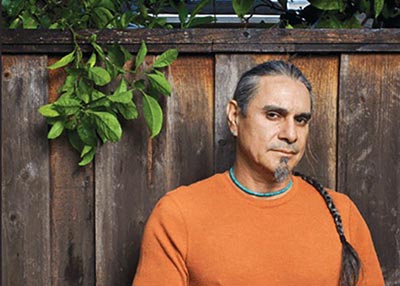 I was raised pretty traditionally in my native community, and part of that upbringing included knowledge of plants from our local environment. I was lucky to have a mother and grandmother who made sure that I knew a lot about our food and medicinal plants. When I was working on my Master’s degree and had to start focusing on what I wanted to do, I thought, “It’d be great if I could focus on all of this plant knowledge I have.” I was then told by one of my mentors that I was an ethnobotanist, but I didn’t really know what that was. I started digging into it and made contact with one of the leading ethnobotanists at the time, Richard Ford. It turned out he was getting ready to start an ethnobotany field school in New Mexico. I went to the field school and met him. He taught me how to fly fish, and we became very good friends. That led me to ethnoecology, the study of the direct relationship between peoples and their local environments, and finally to what I’m doing now: focusing on traditional food ways and mitigation of climate change problems.
I was raised pretty traditionally in my native community, and part of that upbringing included knowledge of plants from our local environment. I was lucky to have a mother and grandmother who made sure that I knew a lot about our food and medicinal plants. When I was working on my Master’s degree and had to start focusing on what I wanted to do, I thought, “It’d be great if I could focus on all of this plant knowledge I have.” I was then told by one of my mentors that I was an ethnobotanist, but I didn’t really know what that was. I started digging into it and made contact with one of the leading ethnobotanists at the time, Richard Ford. It turned out he was getting ready to start an ethnobotany field school in New Mexico. I went to the field school and met him. He taught me how to fly fish, and we became very good friends. That led me to ethnoecology, the study of the direct relationship between peoples and their local environments, and finally to what I’m doing now: focusing on traditional food ways and mitigation of climate change problems.
Can you explain the Rarámuri concept of iwıgara?
The simplest way to translate that concept is “shared breath.” Iwigara is a very complex idea; it took me 350 pages to write about it in my dissertation. But what it comes down to is that for my people, and for a lot of other indigenous communities, everything around us is alive and shares the same breath. Therefore, everything is related to us. We’re not above or below all of nature. We occupy the same hierarchical space as rocks, little bugs, and the fish I caught yesterday in the river.
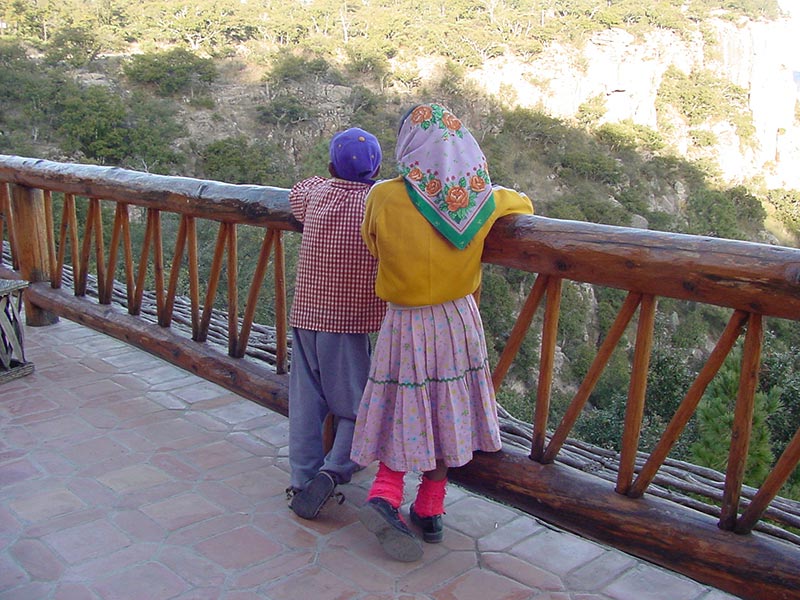
In 2000, you published an article in the journal Ecological Applications entitled “Kincentric ecology: indigenous perceptions of the human-nature relationship.” Is kincentric ecology the same thing as iwigara?
It’s not exactly synonymous. Kincentric ecology was something I came up with to try to translate an indigenous perspective into a Western paradigm. The closest I could come up with was to connect it to the Western concept of ecology. Ecology is not a Native concept. It’s a Western, deterministic approach to studying and defining interactions in ecosystems. For Native peoples, that’s just the way things have always been. You don’t need all these fancy words like “stochastic movements” to explain it.
Speaking of language, I understand that the Rarámuri have no word for “wilderness.” Are there other Western words or terms whose absence in indigenous languages may tell us something?
The first one that comes to mind is the Western category of “poisonous plants.” I’ve never come across an indigenous language that maintains that category. There are plants that are “dangerous,” or plants that you have to be careful around, but none that will outright kill you. Even the notion of “poisonous” is alien to most indigenous world views. That category would be more closely associated with a powerful energy—plants/entities with which only the initiated or most knowledgeable should interact. This sets up a paradigm that relates to the roles of individuals. The concept of initiation means that not just anyone can read a book and learn how to deal with those plants. You have to know all of the interactions those plants have with the rest of the universe before you interact with them. That requires a hierarchy and sophistication of knowledge of one’s environment.
In Eating the Landscape, you write, “Indigenous paradigms suggest…that the human-nature relationship requires both parties to participate in the dance of life…” Can you share an example of the active reciprocity that exists between the people of indigenous cultures and the plants and animals of the landscapes they inhabit, and the way that reciprocity benefits ecological community?
 When I was a program officer for the Christenson Fund, a foundation with a mission to bring financial support to indigenous communities that are still maintaining their traditional land management practices, I was invited to travel to Ethiopia with an Ethiopian program officer. We were not far from Awassa, and he kept pointing out these gigantic Ficas tress that were in the center of most traditional communities. It turns out the tree is where the headsmen meet to discuss practical matters, plan for the harvest, make political decisions, etc. We learned that the trees are being threatened by Christian missionaries who have decided, because of the traditional meetings taking place at the trees, that the trees are satanic and need to be removed. With the support of the Ethiopian government, the trees are starting to be cut down. The indigenous communities have been fighting this, and their argument is that “If the trees disappear, our whole connection to our landscape disappears, and when that happens, the whole ecosystem will fall apart.”
When I was a program officer for the Christenson Fund, a foundation with a mission to bring financial support to indigenous communities that are still maintaining their traditional land management practices, I was invited to travel to Ethiopia with an Ethiopian program officer. We were not far from Awassa, and he kept pointing out these gigantic Ficas tress that were in the center of most traditional communities. It turns out the tree is where the headsmen meet to discuss practical matters, plan for the harvest, make political decisions, etc. We learned that the trees are being threatened by Christian missionaries who have decided, because of the traditional meetings taking place at the trees, that the trees are satanic and need to be removed. With the support of the Ethiopian government, the trees are starting to be cut down. The indigenous communities have been fighting this, and their argument is that “If the trees disappear, our whole connection to our landscape disappears, and when that happens, the whole ecosystem will fall apart.”
For indigenous peoples, part of our responsibility is to make sure that creation continues.
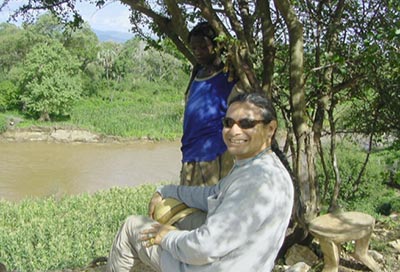
You might be thinking, “that’s just a tree. It’s not that big a deal.” But it’s respective of how indigenous communities maintain a sense of responsibility with our place. I have seen this everywhere I go in the world—with traditional Alaskan communities, with Maori in New Zealand, and with my people and other Native peoples of North America. We have an ongoing responsibility to minister to the land, and we do this through ceremony. For non-native peoples, including those from Judeo-Christian based religions, the Earth was created once. For indigenous peoples, part of our responsibility is to make sure that creation continues. Every time we hold a traditional ceremony—by maintaining meeting trees in Ethiopia or by making offerings as I raise my traditional plants in my backyard–we are recreating our universe.
In Eating the Landscape, you write that “Cultural survival can be measured by the degree to which cultures maintain a relationship with their bioregions” and that “the interior landscape reflects the indigenous relationships to their lands.” What do you mean by the “interior landscape?”
Borrowing from [acclaimed novelist, poet, and essayist of the Laguna Pueblo] Leslie Marmon Silko, another way to describe it is an “interior, cognitive journey.” It’s the way that we maintain our ecological and cultural knowledge through the telling and retelling of our stories. Our very identity is embedded in the land. The land holds our history. Whenever I go back home to Chihuahua, I drive south from the border at El Paso, I keep going south and pass through Cuauhtemoc, I turn left at La Junta, and go about another 15-20 miles and I see the first pino triste (which means “sad pines”), a species of pine endemic to the mountains of Chihuahua. Not long after that, I see Pahuachique Hill, where two children survived a huge flood. After the flood, they were given seeds by our Creator to put out into the land, and that is where corn came from. From this corn emerged the next round of our people. We are literally children of corn. Whenever I see those pine trees and that hill, all that history, all that sense of identity, purpose, and world view, is reactivated in my head.
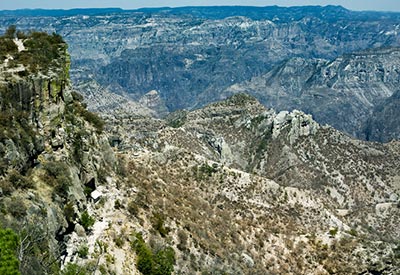 That is your internal landscape.
That is your internal landscape.
Yes, that is my cognitive journey.
In Eating the Landscape, you write, “A Native field is a diversity condo that can be eaten.” What are some of the ways that methods of native agriculture enhance the diversity of the landscape?
You never see mono-cropping in a typical, indigenous field. There is always a mix of different plants, and that diversity invites other species of insects, small mammals, etc. into that area as well. Around the borders of and within a typical bean or corn field, for example, there are often plants that offer potential for wildcrafting [harvesting natural, wild plants for food or medicinal purposes]. I once took an ethnobotanical field school class to the cornfields of Eric Polingyouma, a Hopi elder in the community of Second Mesa on the Colorado Plateau. In trade for the stories and other knowledge Eric was giving my students, my students volunteered to weed his field. Eric spent more than 45 minutes telling the students what plants not to weed. He wanted to make sure certain plants stayed there. They were what we’d call weeds, but to him and to the Hopi, they were an important part of the cornfield’s ecosystem.
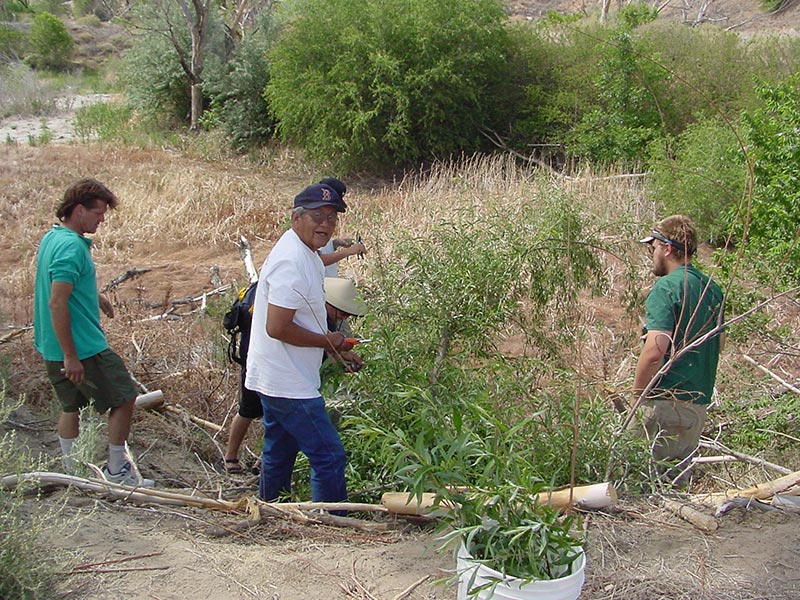
Native agriculturalists tend to operate that way—they invite diverse species of plants in and around their main plants. We also farm in a way that doesn’t kill the mycorrhiza and useful bacteria embedded in the soil. We invite worms and other insects into the soil. We don’t have a problem if we lose part of the harvest because we know that these other insects and micro-bacteria are necessary for the larger operation of the ecosystem. Things like pesticides are unheard of because they kill everything.
When I used to pick berries as a child, my grandmother would tell me, “Leave some for little brothers and sisters and larger brothers and sisters, and pick some in the middle of the bush.” There is a recognition that we’re not the only ones operating in any specific ecosystem.
I was struck by how often the subject of singing came up in your book Eating the Landscape…the Paiute Salt Song singers singing the landscape back to life in the Mojave Desert, Yaqui Deer singers in the Sonoran Desert, Seri singers along the Sea of Cortez, and Coahuila Bird Song singers. What can you tell us about the significance of song and language in the resilience and preservation of biocultural diversity?
Language is culture. Everything of a culture is embedded and encoded in our language and in songs, including tons of ecological references and knowledge. If you don’t know the language, the Coahuila Bird Songs are just pretty sounding, powerful songs. But if you know what they’re singing about, they become more powerful. They are singing about interactions between certain species of birds, insects, and sometimes plants. The song is a reflection of the ongoing, important interactions that happen all around us, and our role in them. Each of these songs is a library of our ecological knowledge.
Each of these songs is a library of our ecological knowledge.
In Eating the Landscape, you visit a variety of indigenous communities in the American southwest and northern Mexico. But as different as they are, they seemed to share a common set of circumstances: loss of language and culture; lack of youth involvement in traditional, sustainable agriculture; a reliance on easily accessed processed and fast foods, and diet-related health problems like diabetes. You highlight several programs in different communities that are reviving both traditional cultures/resilience and regional ecology by reviving indigenous food ways. Many of these programs center around young people. Did you notice common factors in these programs that were crucial to their success?
Their inclusiveness was central to their success. The people involved in the organizations and programs I wrote about weren’t thinking, “This is just for us.” None of those young people participating in Native Movement’s Edible Landscapes projects around Flagstaff ever said, “This is just for us Hopi” or “This is only for us Navajo.” In some of those groups and programs, there are a lot of non-native young people involved. Even down in Mexico, if there is a Mestizo person who wants to work with my people, no one ever says no as long as their heart is good. If their heart is good, they’ll say, “You are welcome. Come join us.”
Can you talk about “resilience theory” and share some examples of indigenous innovation based on long-term knowledge?
Resilience theory began with archaeology. Archaeologists were trying to figure out why some civilizations lasted longer than others. They were borrowing ideas from ecosystem experts who were also trying to describe why certain ecosystems were more resilient than others. When I was with the Christensen Fund, I had some good conversations with [Canadian ecologist and one of the conceptual founders of ecological economics] Buzz Holling. He said that whenever you have resilient ecosystems, long-term memory was working in conjunction with short-term memory. As I thought about that more, I realized that this could be applied to indigenous communities that are still here.
After the conquest, and after ongoing colonialization and European occupation of North and South America, why are certain Native communities still here? Well, we’re the ones who have been more resilient. We’re the ones who have been able to hang on through our traditions but still be flexible enough to allow for new ways of thinking and doing things. Intermixed in this resilience model is a periodic disruption.
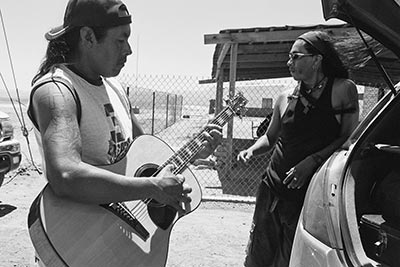
Every now and then, you have to have a little revolt. You have to have young people saying, “You know what? Let’s start using the Internet to our advantage,” or, one of my favorite examples: “Let’s start reconfiguring our traditional songs into punk rock music.” If you read my book, you know I’m referring to El Indio. [El Indio is a Seri musician in Desemboque, Sonora, Mexico, who sings traditional Seri songs in a punk rock style.] El Indio is the coolest guy I ever met. He’s a punk rock singer with videos on YouTube, but he is singing the same lyrics that the elders sing. The difference is that they are backed by crunching guitar and banging drums, and the young Seri kids love it. That is a great example of the long-term memory mixing with the short-term memory with that little revolt. As long as you have that, resilience is guaranteed, because things never get stale.
Speaking of resilience…you are studying the connections between climate change and indigenous food ways. Are there connections between the restoration of traditional food ways and climate change adaptation? If so, can you share an example?
What I am noting, along with other researchers, is that first, American Indians have grown and hybridized food in harsh and changing environments for thousands of years. As a result there are likely crops such as Tohono O’odham 60 corn that should be studied for their potential for helping larger scale agriculture adapt to global warming. Next, indigenous agricultural practices actually maintain and restore nutrients to soils and often act to stem erosion and raise water tables. All of the facets of indigenous agriculture could come into play as humanity works to mitigate the impacts of climate changes.
We want to be careful not to romanticize indigenous people and their relationships with the land, so I appreciated your mention of the failure of the Tohono O’odham people’s attempt around the Hohokam period (AD 950-1500) to use a canal irrigation system that drew water from the Salt and Gila Rivers rather than relying on flows down washes. You explain that that system likely failed because of over salinization of the desert soils. What might we learn from the Tohono O’odham’s rebound from that failure?
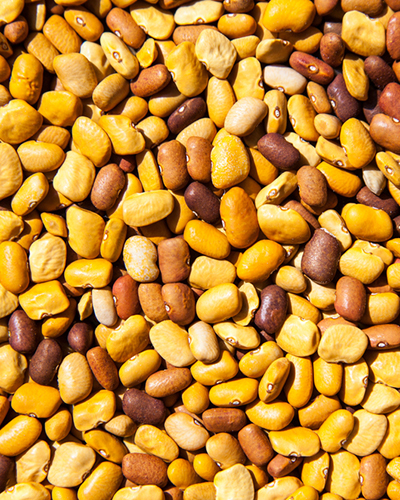
That there’s a limit to what the Sonoran Desert can offer. It is one of the most biodiverse regions of the world, and Native peoples have done it for a long time, but there are limitations to the availability of resources. After the disaster of their ancestors, the Hohokam, the people spread out to form smaller, familial, banded communities. They realized that instead of forcing the desert to do something for them, they should realize what the desert is offering and work with that. That is where the concept of Ak’ Chin farming emerged. [Ak-Chin involves planting downslope from a wash—a seasonal floodplain created by winter snows and summer rains—and using natural irrigation from floodwaters.] If you plant 60-day pinole corn and tepary beans in the washes and hybridize the plants to reach maturity and produce fruit faster, then the summer monsoons that bring moisture to those washes will provide what you need. It took the people several generations to figure this out, but they did. That’s another example of resilience.
Can you tell us a bit about the Tohono O’odham Community Action (TOCA) program, and how it is impacting culture and ecology today?
TOCA brought back Ak’ Chin farming. If you go visit their complex of buildings, outside of Tucson, and look south into the Sonoran Desert, you think all you see is more Sonoran Desert. But if you walk down a couple hundred yards, you realize that you’re in the middle of an incredible corn and bean field. Each tepary bean bush is producing hundreds of beans. Short, squat corn plants have 12 cobs on them. In the process of bringing back this kind of farming and returning to traditional, ancestral foods, TOCA is trying to attack one of the biggest plagues of Native communities: adult onset diabetes. TOCA also has educational programs that encourage kids to eat more traditional foods and to work in the fields or walk and do some wildcrafting, so that by time they reach the age of 35 they aren’t sitting on dialysis machines once a week. Connected to all of this, of course, is the positive ecological impact of farming the desert the way it should be farmed.
When a food way is reintroduced to an indigenous community, the process of the food way gets reintroduced. With the process comes ways of talking about the process, so the language starts to reappear. When the language starts to reappear, the ceremonies start to reappear, and so does the culture and the sense of identity and purpose. Then, what comes back are those cognitive journeys we talked about earlier.
(Video published by California Newsreel, 2014)
In Eating the Landscape, you write, “Ecologists and conservation biologists today recognize an important relationship between cultural diversity and biological diversity.” How can we move beyond recognition to action? How can we infuse traditional ecological knowledge and kincentric ecology in the practices of ecological restoration, conservation planning, and regenerative design?
I teach in the Ethnic Studies department, and I’m currently teaching a class called “Racism in America.” Recently, there was an article in High Country News about how more people of color were starting to get into the outdoors. I told my students about it and then showed them pictures from REI’s web site and Patagonia’s web site. I asked, “What’s missing from these pictures?” The students asked, “Where are the people of color?”
Conservation and restoration organizations need more color. People of color want to breathe clean air and drink clean water. They are just as interested in ecological restoration and conservation planning as others, but for some reason, they have not been invited into the conversation. As a result, I think the conservation movement has been missing out on a lot of innovative ways of restoring wild and urban landscapes.
Conservation and restoration organizations need more color.
For a while, I facilitated retreats for the Center for Whole Communities where we brought together social justice advocates and environmental activists. For a week, we’d teach them how to talk to each other. In a lot of ways, they’re trying to do the same thing, but they don’t know how to talk to each other. People involved in ecological restoration and conservation need to figure out how to invite social justice activists -who are mostly, it turns out, of color—to their missions. And vice versa. They can learn so much from each other.
If you had to pick one indigenous food that best exemplifies or embodies the concept of iwigara, what would it be and why?
It would have to be beans. Whenever I think about growing up with my family and my tribe, I think about my mother cooking, and no matter what was going on, there were always beans available. Beans are very close to being a perfect food. They are a great source of protein, other aminos, and soluble and insoluble fibers. They taste good, and they’re versatile. They grow practically anywhere. The great thing about beans is that when they grow, they don’t just take nutrients from the land, they bring them back to the soil in the form of fixed nitrogen.
I read a beautiful essay you wrote for the Center for Humans and Nature called “I want the Earth to know me as a Friend,” in which you discuss the notion of “Living in order to become the kind of ancestor that one would hope to be.” I was going to ask you what kind of ancestor you want to be, but I think the title of your essay answers that question.
That is true.
How do you think we can we get more people to ask themselves this kind of question?
This is something I have struggled with as a teacher, and I finally came up with a kind of solution. A couple of years ago, I started teaching a freshmen course at Cal State East Bay called “American Indian Science.” I wanted the students to get a little taste of how a traditional indigenous person relates to a landscape, so I came up with an assignment. I said, “For the rest of the 10-week quarter, once a week, watch a sunrise or sunset from the same exact place at the same exact time of day.” I told them to be aware of what was going on around them and write about what they noticed in a journal. At first, they were like, “Eh, there’s not much going on.” But by the third or fourth week, they were writing things like, “I noticed a deer coming to the same bush” or “I noticed a couple holding hands and walking up the hill at the same time every day.” One of the students picked a spot in a parking lot by the San Mateo bridge. She just watched the cars and the sun at the same time. As she was watching hundreds of people crossing the bridge, she started making connections to the web of life and the universe. It really expanded her thinking. More Americans need to do that. By the end of the assignment, most of the students realized that they wanted to keep doing this practice of just stopping and paying attention.
So that is my answer: people need to find a way, every now and then, to just stop. Stop and be aware of what is going on around you. Watch a sunrise. Watch a sunset.
Many thanks to Enrique Salmón for taking the time to share his perspective, and for inspiring this writer to watch more sunsets.
Organizations featured in Enrique Salmón’s book, Eating the Landscape: American Indian Stories of Food, Identity, and Resilience:
New Mexico Acequia Association
